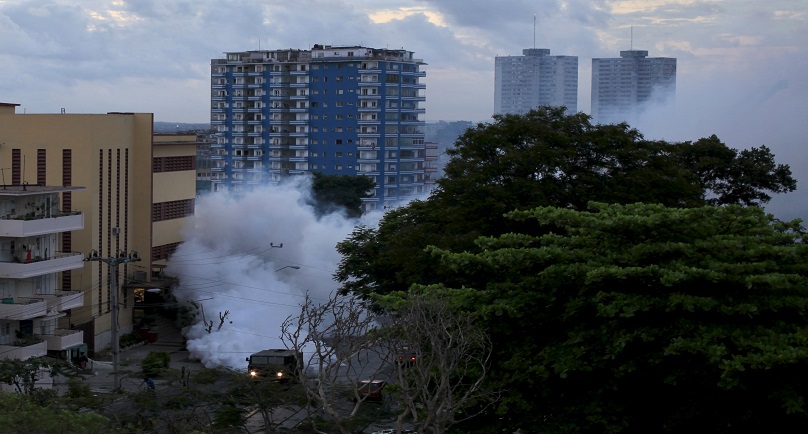Image: A military truck carries out fumigation in a neighborhood to stop the breeding of the dengue mosquito in Havana April 5, 2016. REUTERS/Enrique de la Osa
By Alisa Tang
BANGKOK (Thomson Reuters Foundation) – The Philippines this week launched the world’s first public dengue immunisation programme, vaccinating 600 children at a school in the capital Manila with the goal of reaching 1 million students across the country this year.
Dengue, also known as “breakbone fever”, has spread rapidly around the world in recent decades, and about half the world’s population is now at risk.
Scientists have been working on a vaccine for decades, and the first one received market approval in December in Mexico.
Several other vaccines are under development, while researchers are also looking at ways to control the mosquitoes that’spread dengue and other viruses such as Zika.
Here are some facts about dengue and prevention efforts.
WHAT IS DENGUE?
* Dengue, a mosquito-borne viral disease, often causes a flu-like illness, with symptoms including high fever, severe headache, muscle and joint pain, nausea, vomiting and rash. * It can develop into the deadly severe dengue, or dengue haemorrhagic fever, characterised by severe abdominal pain, persistent vomiting, rapid breathing, bleeding gums and blood in vomit. * There is no specific treatment for dengue. Patients are generally asked to rest, drink plenty of fluids and take medication to reduce fever and joint pains. * Fatality rates can be below 1 percent with proper medical care, but without care, can be as high as 20 percent in patients with severe dengue.
WHO IS AFFECTED?
* The annual number of dengue cases has increased 30-fold in the last 50 years, and there are now an estimated 390 million infections per year. * The disease is now endemic in more than 100 countries in Africa, the Americas, the Eastern Mediterranean, Southeast Asia and the Western Pacific. * Severe dengue was first recognised in the 1950s during dengue epidemics in the Philippines and Thailand. Before 1970,only nine countries had experienced severe dengue epidemics. * Severe dengue has become a leading cause of hospitalisation and death among children in Asia and Latin America. Asia has the most cases, with 67 million people infected per year.
HOW CAN DENGUE BE PREVENTED?
* Dengue transmission can be prevented by fighting the mosquitoes which carry the disease, getting rid of places for them to lay eggs by covering or emptying outdoor water containers, and disposing of solid waste properly. * Protection such as window screens for houses, long-sleeved clothes and insecticide are also used. * Health experts have called for an integrated approach to fight dengue and for vaccines to be part of the tool box to fight the virus.
HOW EFFECTIVE IS THE VACCINE?
* Sanofi studies of Dengvaxia, a three-dose vaccine administered over the course of a year, said it prevented eight out of 10 dengue hospitalisations. * A new dengue vaccine developed by scientists from the U.S.National Institutes of Health (NIH) shows promise, with 100 percent protection in a small group, according to a study published in March.
WHERE IS THE VACCINE AVAILABLE?
* Dengvaxia, which is approved for use in individuals aged 9 to 45, is registered in the Philippines, Mexico, Brazil and El Salvador, with regulatory review processes underway in other countries. * In the Philippines, fourth grade students who are nine or older will be vaccinated, with an injection in the upper arm. * The free vaccinations are taking place at public schools in the capital Manila and adjacent regions to the north andsouth, which have the highest number of dengue cases.
Sources: World Health Organization, Philippines Department of Health, Sanofi Pasteur.
(Reporting by Alisa Tang, editing by Alex Whiting. Please credit the Thomson Reuters Foundation, the charitable arm of Thomson Reuters, that covers humanitarian news, women’s rights, corruption and climate change. Visit http:https://news.trust.org to see more stories)
Copyright 2015 Thomson Reuters. Click for Restrictions.


